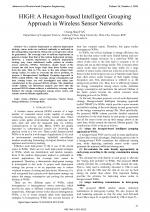| 1/2016 - 6 |
HIGH: A Hexagon-based Intelligent Grouping Approach in Wireless Sensor NetworksFAN, C.-S. |
| Extra paper information in |
| Click to see author's profile in |
| Download PDF |
Author keywords
wireless sensor networks, cluster head, energy efficiency, coverage ratio
References keywords
sensor(27), networks(20), deployment(11), systems(7), random(5), chen(5), information(4), computing(4), communications(4)
Blue keywords are present in both the references section and the paper title.
About this article
Date of Publication: 2016-02-28
Volume 16, Issue 1, Year 2016, On page(s): 41 - 46
ISSN: 1582-7445, e-ISSN: 1844-7600
Digital Object Identifier: 10.4316/AECE.2016.01006
Web of Science Accession Number: 000376995400006
SCOPUS ID: 84960075118
Abstract
In a random deployment or uniform deployment strategy, sensor nodes are scattered randomly or uniformly in the sensing field, respectively. Hence, the coverage ratio cannot be guaranteed. The coverage ratio of uniform deployment, in general, is larger than that of the random deployment strategy. However, a random deployment or uniform deployment strategy may cause unbalanced traffic pattern in wireless sensor networks (WSNs). Therefore, cluster heads (CHs) around the sink have larger loads than those farther away from the sink. That is, CHs close to the sink exhaust their energy earlier. In order to overcome the above problem, we propose a Hexagon-based Intelligent Grouping approacH in WSNs (called HIGH). The coverage, energy consumption and data routing issues are well investigated and taken into consideration in the proposed HIGH scheme. The simulation results validate our theoretical analysis and show that the proposed HIGH scheme achieves a satisfactory coverage ratio, balances the energy consumption among sensor nodes, and extends network lifetime significantly. |
| References | | | Cited By |
Web of Science® Times Cited: 7 [View]
View record in Web of Science® [View]
View Related Records® [View]
Updated today
SCOPUS® Times Cited: 8
View record in SCOPUS® [Free preview]
View citations in SCOPUS® [Free preview]
[1] Network Lifetime Enhancement of Wireless Sensor Networks Using EFRP Protocol, Rajendran, Senthil Kumaran, Nagarajan, G., Wireless Personal Communications, ISSN 0929-6212, Issue 2, Volume 123, 2022.
Digital Object Identifier: 10.1007/s11277-021-09212-6 [CrossRef]
[2] Energy-efficient clustering method for wireless sensor networks using modified gravitational search algorithm, Ebrahimi Mood, Sepehr, Javidi, Mohammad Masoud, Evolving Systems, ISSN 1868-6478, Issue 4, Volume 11, 2020.
Digital Object Identifier: 10.1007/s12530-019-09264-x [CrossRef]
[3] Overview of DOS attacks on wireless sensor networks and experimental results for simulation of interference attacks, Gavrić, Željko, Simić, Dejan, Ingeniería e Investigación, ISSN 2248-8723, Issue 1, Volume 38, 2018.
Digital Object Identifier: 10.15446/ing.investig.v38n1.65453 [CrossRef]
[4] THWSN: Enhanced Energy-Efficient Clustering Approach for Three-Tier Heterogeneous Wireless Sensor Networks, Kumar, Nitin, Rani, Preeti, Kumar, Vinod, Athawale, Shashikant V., Koundal, Deepika, IEEE Sensors Journal, ISSN 1530-437X, Issue 20, Volume 22, 2022.
Digital Object Identifier: 10.1109/JSEN.2022.3200597 [CrossRef]
[5] On Calculating the Packing Efficiency for Embedding Hexagonal and Dodecagonal Sensors in a Circular Container, Prvan, Marina, Ožegović, Julije, Mišura, Arijana Burazin, Kalashnikov, Vyacheslav, Mathematical Problems in Engineering, ISSN 1024-123X, Issue 1, Volume 2019, 2019.
Digital Object Identifier: 10.1155/2019/9624751 [CrossRef]
Disclaimer: All information displayed above was retrieved by using remote connections to respective databases. For the best user experience, we update all data by using background processes, and use caches in order to reduce the load on the servers we retrieve the information from. As we have no control on the availability of the database servers and sometimes the Internet connectivity may be affected, we do not guarantee the information is correct or complete. For the most accurate data, please always consult the database sites directly. Some external links require authentication or an institutional subscription.
Web of Science® is a registered trademark of Clarivate Analytics, Scopus® is a registered trademark of Elsevier B.V., other product names, company names, brand names, trademarks and logos are the property of their respective owners.
Faculty of Electrical Engineering and Computer Science
Stefan cel Mare University of Suceava, Romania
All rights reserved: Advances in Electrical and Computer Engineering is a registered trademark of the Stefan cel Mare University of Suceava. No part of this publication may be reproduced, stored in a retrieval system, photocopied, recorded or archived, without the written permission from the Editor. When authors submit their papers for publication, they agree that the copyright for their article be transferred to the Faculty of Electrical Engineering and Computer Science, Stefan cel Mare University of Suceava, Romania, if and only if the articles are accepted for publication. The copyright covers the exclusive rights to reproduce and distribute the article, including reprints and translations.
Permission for other use: The copyright owner's consent does not extend to copying for general distribution, for promotion, for creating new works, or for resale. Specific written permission must be obtained from the Editor for such copying. Direct linking to files hosted on this website is strictly prohibited.
Disclaimer: Whilst every effort is made by the publishers and editorial board to see that no inaccurate or misleading data, opinions or statements appear in this journal, they wish to make it clear that all information and opinions formulated in the articles, as well as linguistic accuracy, are the sole responsibility of the author.





